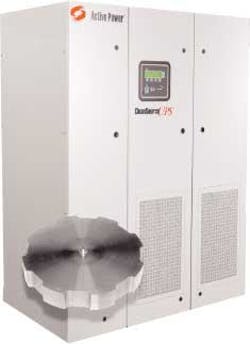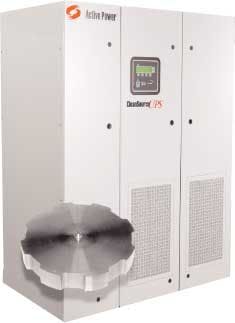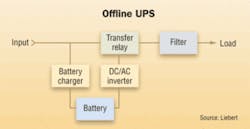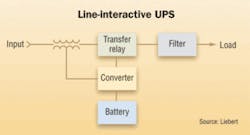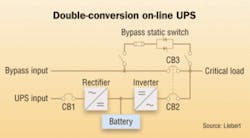UPS systems face challenges in high-density data centers
Emerging devices may be smaller, and better at beating the heat.
Changes are coming to uninterruptible power supplies. But with the proliferation of high-density data centers, uninterruptible power supply (UPS) users say the changes--smaller, capable of constant reliable power, and somehow able to avoid producing heat at high levels-can’t happen fast enough.
UPSs are basically power storage systems with interfaces to match them to utility power and computer systems. They include three important parts: A set of batteries, an inverter that transforms the low-voltage direct current of the batteries into the standard alternating current used by computers, and a battery charger that assures that reserve power is always available inside the batteries. Some types of UPSs also provide power conditioning and remove noise, sags, frequency variations and other power-quality problems that can affect sensitive electronics.
UPS systems are classified based on the degree of power conditioning they provide. Offline UPSs-also known as passive standby systems--have high-efficiency during normal operation, and their inverters keep the batteries charged while in stand-by mode. In the event of a power problem, the inverter draws energy from the battery and powers the load.
Line interactive systems are able to filter out some, but not all, power disturbances. They are traditionally deployed for desktop power protection and in network closets that are not considered mission-critical. Double conversion, (or, online) UPS systems remove all power-quality problems by converting incoming power from AC to DC and then back to clean AC. This is the preferred choice for data centers and other high availability applications.
Backup power on-the-fly
While UPS systems have traditionally used batteries to provide backup power in the event of utility outages, for some applications, flywheel technology has emerged as an alternative or supplement to batteries. Flywheel UPSs depend on electricity to charge a flywheel until it reaches maximum speed. The wheel then continues to spin with minimal support. When it senses a loss of power, energy from the spinning wheel supplies a facility’s load.
Higher-density servers, such as blades, are being deployed in computer rooms and data centers to meet an almost insatiable demand for computing capacity. These high-density servers are driving up capacities, and more and more processing capabilities are being packed into smaller areas. Additionally, new technologies, such as Voice over Internet Protocol (VoIP) are placing more importance on the network itself by asking it to support voice and data.
“VoIP offers a number of benefits to organizations of every size, but it also reduces the tolerance to downtime across the network,” says David Joy, vice president of marketing/Power Division for UPS manufacturer Emerson Network Power-Liebert. “When a network supporting VoIP goes down, voice and data traffic are lost. This reality is causing many organizations to reevaluate their protection systems, both inside and outside the data center. A converged network requires a more robust and adaptive power and cooling system than may have been necessary to support only data communications.”
These applications require a higher level of business-critical continuity, and that includes reliable UPS solutions.
“As we as a society move more into the digital world, things that are controlled by digital signal processors rely more heavily on quality and continuous power,” says Derek Jones, marketing communications manager for UPS manufacturer Active Power Inc. “Equipment today, in general, is much more sensitive to power fluctuations.”
A charged market
As critical applications, such as computer use, continue to grow, reliable power becomes more necessary. Not surprisingly, the market for power-protection continues to increase as well.
“Ten years ago, hospitals sent lab testing to outside guys; now, it’s done internally,” notes Denzil Merrill, vice president of Standard Three Phase Products for MGE UPS Systems Inc. (www.mgeups.com). “They can’t afford to have a loss of power and ruin that lab test. A UPS would provide a bridge that would protect that outage.”
Enterprise end users argue that the marketplace has gone through market maturation, with products having made the journey from being competitive to being something less competitive. The products are extremely stable and reliable, but the metamorphosis has taken its tolls as manufacturer consolidation and price reductions have led to a market filled with similar UPS systems.
“The market will look for new solutions,” assures Steve Friedman, principal/managing director for UPS service and sales organization DSA Encore Inc. (www.dsaencore.com).
But Emerson Network Power-Liebert’s Joy argues that the UPS technology that exists today is capable of meeting data center challenges, and that the key is in how the technology is applied.
Joy says high-density data centers are having more of an impact on cooling, as opposed to powering, technology. “Today’s UPS technologies are more than capable of meeting the power demands of the highest density facilities,” he says. “We do that through an adaptive architecture that is capable of responding to changes in capacity, density or availability levels.”
Other manufacturers are transforming their designs, attempting to provide UPS systems with higher reliability and fewer components. As the products have become more reliable--where older units were 60% efficient, today’s UPS systems are 90% efficient-their costs have dropped drastically.
“The units now are so much more evolved than what they used to be,” says Dwight Kauf, regional sales manager for UPS JT Packard (www.jtpackard.com), a national UPS service and equipment sales organization.
Data centers driving change
Meanwhile, the proliferation of high-density data centers is driving the need for competitive change. Increasingly, the UPS’ place in today’s high-density data centers is coming under scrutiny because they run into the same situation as other devices-their heat density per square inch introduces problems. Server technology is certainly changing at a faster pace than UPS technology. High-density servers have power requirements of 3 to 5 kilowatts (kW) per rack or 80 to 100 watts per square foot. Friedman says there is a large demand in the market for these high-density boards. And they come with a price. The density of the data center determines the overall power for the center. As the centers become more dense, heat generation and power needs become an issue. “They need more technology for cooling and power,” Merrill says.
Joy says the challenge for data center designers and managers is to create facilities that can not only support the current generation of servers, but also the next generation and the one after that. “Our customers are replacing servers every three to five years, while the UPS and other data center systems tend to have a 15-year lifecycle,” says Joy. “From a cost of ownership perspective, this is an advantage. By deploying properly sized power building blocks, customers can maintain the flexibility to change while still upholding high availability standards at a lower total cost of ownership.”
Joy says this makes the decisions made when the UPS system is first installed critical to the long-term success of the facility. “It is always tempting to drive down initial costs,” says Joy. “But you have to make sure when you do that you are not compromising the performance or adaptability of the system.”
Friedman says the challenges are daunting, however, as data center technology continues to outstrip the ability of UPS systems to support it. “For a 300-watt server, you’d need a UPS system with 3-kVA,” says Friedman. The kilovolt-ampere, or kVA, is a measurement used to rate the capacity of uninterruptible power supplies. “You need the space, and the heat requirements and the demands that exist are outside the ability of current technology to support it.”
Joe Rickard, CTO for Offsite (www.off-site.com), agrees. Offsite owns and manages a five-acre business continuity campus located between Chicago, IL and Milwaukee, WI. The campus includes a data center hotel used by money managers, brokerage firms and financial services corporations.
Rickard says today’s blade servers are pushing high density in data centers, and raising questions about the ability of UPS systems to meet their power requirements. “It’s true,” agrees Rickard. “To make it work, you have to make sure it (UPS system) can handle the amount of amps for what you require.”
And as the data center becomes more dense, the more UPS systems you need, says Jones. Bulky UPS systems take up room in a valuable center where costs are calculated in square feet.
In response, some manufacturers are making smaller UPS systems. Integrated bipolar transistors on the input and outputs, along with digital signal processing in circuit boards, have allowed for most of the size reduction. A 225-kVA unit built in the mid-1980s, for example, would be about 85 inches long. Now, the same unit would be 56 inches long or smaller.
Susan Walker, manager of enterprise computing services, St. Luke’s Episcopal Health System (www.sleh.com), oversees a 3,500-square-foot, raised-floor data center that contains two UPS systems. The servers in the room are all dual-power supply, so that if one UPS system were to fail, they could depend on the remaining UPS.
Walker says the health system’s UPSs have battery cabinets that are approximately 10 feet long and eight feet high. The cabinets are mounted in the building’s basement instead of the data center, due to the amount of space they take up. “Batteries take up a huge footprint,” says Walker. “These cabinets are full of batteries for one UPS.null
BRIAN MILLIGAN is senior editor for Cabling Installation & Maintenance.
